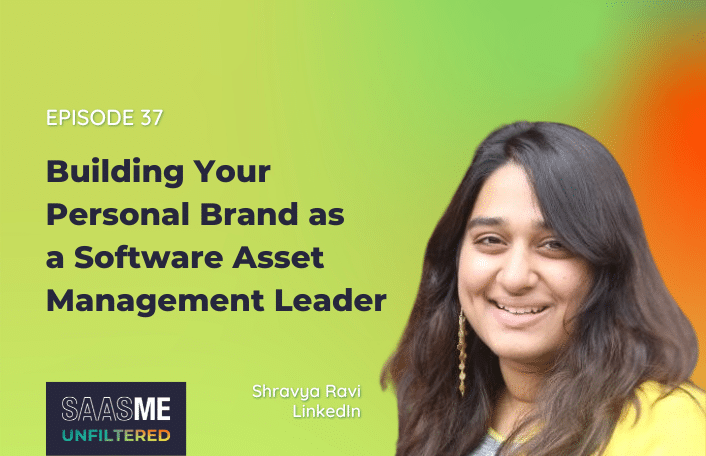09/21/2023
Table of Contents
“Execute with precision and lead with a vision” is the mantra Shravya Ravi lives and breathes as a software asset management leader. From helping companies with their software management strategies as a consultant at Deloitte to leading an innovative SaaS management program today at LinkedIn, Shravya is a powerhouse. In this episode, she shares the secrets to building your personal brand as a SAM leader – no matter your rank in the organization – and driving significant change and business results.
Episode Summary
As a software asset manager, building your personal brand is vital to driving SaaS management effectiveness. However, SAMs have often been viewed as individual contributors.
According to Shravya Ravi, “an evolution from that mindset is needed to step into the SaaS world.”
Why? With the rise of SaaS, the game has evolved. Instead of dealing with just a handful of vendors, we’re now talking about hundreds. And that’s where the challenge lies – how do you communicate and build trust in the data at this scale?
“At some point, software asset managers will be looked at as leaders that are going to influence strategy,” explained Ravi.
This is the call for all you software asset managers out there – it’s time to step up your game. By embracing this new mindset, you can build your personal brand and make a real impact in the world of SaaS management.
Guest Spotlight
Name: Shravya Ravi
What she does: Manager, Asset Management at LinkedIn
Connect with Shravya online: LinkedIn
Episode Highlights
SaaS Is Where the Big Opportunity Lies
“When I was working in consulting, a lot of the times the first question I always asked was, ‘Where’s the money?’ And we always followed the money. I’ve seen a shift personally in the type of work and the work that I’ve done in the last couple of years, where every time I stepped in and did a quick analysis of where the most money is going, especially in the last three years, there was a significant shift in the amount of money spent, on-premise software towards cloud or subscription-based software. And that’s kind of where I started thinking about shifting strategies. Once you follow the money, you see where the biggest opportunities to save are as well, right? So, yeah, I started looking at that moving from on- prem. There’s still spend, it’s not that it’s going away, but from a SaaS perspective, follow the money. Once you have the clarity of what it is that you want to do, once you discover all your SaaS, that’s kind of where you start, at least from the SAM perspective..”
The Biggest Mistake Organizations Make Is Assuming You Know Everything
“The first thing with SaaS, the biggest difference I have noticed with SaaS and your on-prem is the discovery. I want to start with the discovery because finding SaaS is not easy. It’s difficult, complicated, has money, and many, many layers on how we’re going to find what someone is using within the company. Outside of tracking people’s browsers’ histories, which I’m sure Privacy will frown upon, there’s not really a good way, a standardized way to find something that’s being used in your environment. So I think that a visibility portion is really important. If you think that you know everything just by looking at spend, you’re probably wrong. There’s other places you’re going to find SaaS being used that we’re not aware of. So assuming and running a SAM program or a SaaS management program thinking that you know everything would be the first mistake. It’s going to be a continuous discovery. It’s going to have to be an ongoing process.”
Set Yourself Apart as a SAM Leader
“As an individual, to develop as a professional, you strive to become an expert in the core set of skills, which basically could be data analytics, could be understanding contracts really well, could be delivering actual deliverables. It could be a report, or it could be a presentation. All of these are skills that everyone should be really good at, and then you build on top of that. So you trust that people that want to become SaaS management professionals or SAM professionals already have these base skills. And then on top of that what really sets you apart is how you’re going to use insight coming out of these skills in presenting them to the right person or personas, and changing your delivery depending on who you’re talking to. What does the other person want, how are you matching what it is that they’re looking for, and customizing and adapting is what’s going to be one of the differentiating factors when you come across these people.”
Build Your Brand as a Strategic Leader, Not Just a Doer
“Historically I think software asset managers have been looked at as individual contributors or people that execute, an evolution from that mindset is needed to step into the SaaS world because it’s also about volume, right? Before we would deal with 10 different vendors, maybe 20 or 30, now it’s like in the hundreds. And how do you communicate this out? How do you build trust in the data, especially when it’s coming to a scale like this? So I think that all software asset managers at some point, even if they’re individual contributors, will be looked at as leaders that are going to influence strategy. And for my personal advice, for anyone that’s looking to move into that path or are already in that path, is one, you have to create your own opportunities, or find other projects, or projects within your organization that you can influence with whatever you know about your SaaS stack. Using these opportunities that you either made for yourself or found through other projects, you should use that opportunity to show your skills, show your knowledge, the base skills that we were talking about, the analysis and all of that, leveraging that and showing it in these platforms.”
You Need an Executive Sponsor to Be Successful
“You’re lucky if you already have an executive sponsor and a champion that really believes in the true value that SAM or SaaS management can bring to the table. I would always start with finding executive sponsorship, a champion, that is able to bring alignment at the highest levels in the company on the importance of SAM and making sure it’s run, it’s funded, it’s kept accountable. If you think about how many functions and teams touch software, from planning procurement to the end of a software lifecycle, there is no way that even just a SAM team or a SaaS management program can be the one that brings the alignment. It’s always going to be an executive sponsor. So that’s always the first step, from finding someone to do that for you. If it’s challenging to find that within your own functional leader, some of the ways that you could potentially think about doing this is going through and seeing what all areas software touches. It could be security, it could be finance, it could be your IAM teams. There are so many functions and teams that actually have a huge impact on SaaS management, and any one of those functional leaders could also be your champion. And all it needs is one leader saying the right thing in the right forum for you to get that visibility.”
Address SaaS Sprawl with an Evaluation Framework Aligned to Your Company Culture
What does your organization need and want, and what has been your organization’s culture when it comes to SaaS? And do you actually want to change it? Because there’s the acceptance of, hey, this is my company culture, let me drive a strategy to support it. Or hey, every leader I’ve spoken to is not supportive of this culture. Let’s try and change it. So you either take one or the other approach. But at the end of the day, from a tactical perspective, if I think about what it is that we want to do to evaluate all these applications being brought into our environment outside of the company culture on, hey, let me give everyone what they’re asking for versus like doing a deep evaluation of if it’s a right fit or not. An evaluation framework is a must in your procurement process on do you want to build versus buy. Do you have overlapping tools that will do the exact same functionality? Are we creating visibility for the employees to know this is exactly what we have in the company’s ecosystem, you are equipped to do what you need to do by looking at our catalog or whatever that visibility stack is, here’s that preferred application, and all of that. Outside of that, there’s always going to be a layer of financial approval, right? There’s always going to be, hey, are you bringing a million dollar thing into the environment without the right research or without doing that analysis of, is there another tool that would meet your needs. So a lot of these, but if I had to summarize it in one sentence, it has to be a framework that covers technology, finance, risk, and business together.
Top Quotes
6:14 – “Especially in the last three years, there was a significant shift in the amount of money spent, on-premise software towards cloud.”
10:11 – “Assuming and running a SAM program or a SaaS management program thinking that you know everything would be the first mistake.”
14:59 – “All software asset managers at some point, even if they’re individual contributors, will be looked at as leaders that are going to influence strategy.”
22:00 – “All it needs is one leader saying the right thing in the right forum for you to get that visibility.”
Recommended Resources
- The Priory of the Orange Tree by Samantha Shannon
Check out other episodes here, Apple Podcasts, Spotify, or wherever you listen to podcasts.
ABOUT THE AUTHOR

Cory Wheeler
As Zylo’s Chief Customer Officer, Cory is responsible for helping our customers drive ROI and SaaS Management success with Zylo. He helps companies of all sizes effectively discover, optimize, and govern their SaaS through Zylo’s platform and services. Prior to founding Zylo, Cory spent 15 years in finance and procurement, managing categories and sourcing teams at Arthur Andersen, BearingPoint, and both Takeda and Astellas Pharmaceuticals. He built the procurement organization at ExactTarget, and managed the integration with the Salesforce Marketing Cloud procurement organization in 2015. He and his family reside in Indianapolis, IN, where they can be found cheering for the Purdue Boilermakers and Chicago Cubs.

